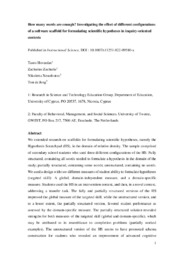| dc.contributor.author | Hovardas, Tasos | en |
| dc.contributor.author | Zacharia, Zacharias | en |
| dc.contributor.author | Xenofontos, Nikoletta | en |
| dc.contributor.author | deJong, Ton | en |
| dc.creator | Hovardas, Tasos | en |
| dc.creator | Zacharia, Zacharias | en |
| dc.creator | Xenofontos, Nikoletta | en |
| dc.creator | deJong, Ton | en |
| dc.date.accessioned | 2022-02-28T13:16:08Z | |
| dc.date.available | 2022-02-28T13:16:08Z | |
| dc.date.issued | 2022 | |
| dc.identifier.uri | http://gnosis.library.ucy.ac.cy/handle/7/65101 | |
| dc.description.abstract | We extended research on scaffolds for formulating scientific hypotheses, namely the Hypothesis Scratchpad (HS), in the domain of relative density. The sample comprised of secondary school students who used three different configurations of the HS: Fully structured, containing all words needed to formulate a hypothesis in the domain of the study; partially structured, containing some words; unstructured, containing no words. We used a design with two different measures of student ability to formulate hypotheses (targeted skill): A global, domain-independent measure, and a domain-specific measure. Students used the HS in an intervention context, and then, in a novel context, addressing a transfer task. The fully and partially structured versions of the HS improved the global measure of the targeted skill, while the unstructured version, and to a lesser extent, the partially structured version, favored student performance as assessed by the domain-specific measure. The partially structured solution revealed strengths for both measures of the targeted skill (global and domain-specific), which may be attributed to its resemblance to completion problems (partially worked examples). The unstructured version of the HS seems to have promoted schema construction for students who revealed an improvement of advanced cognitive processes (thinking critically and creatively). We suggest that a comprehensive assessment of scaffolding student work when formulating hypotheses should incorporate both global and domain-specific measures and it should also involve transfer tasks. | en |
| dc.language.iso | eng | en |
| dc.rights | info:eu-repo/semantics/openAccess | en |
| dc.rights | Open Access | en |
| dc.rights | Attribution-NonCommercial-NoDerivs 3.0 Greece | en |
| dc.rights.uri | http://creativecommons.org/licenses/by-nc-nd/3.0/gr/ | |
| dc.subject | Inquiry | en |
| dc.subject | Improving classroom science teaching | en |
| dc.subject | Pedagogical issues | en |
| dc.subject | Secondary education | en |
| dc.subject | Teaching/Learning strategies | en |
| dc.title | How many words are enough? Investigating the effect of different configurations of a software scaffold for formulating scientific hypotheses in inquiry-oriented contexts | en |
| dc.type | info:eu-repo/semantics/article | en |
| dc.identifier.doi | 10.1007/s11251-022-09580-x | en |
| dc.description.startingpage | 1 | en |
| dc.description.endingpage | 50 | en |
| dc.author.faculty | Σχολή Κοινωνικών Επιστημών και Επιστημών Αγωγής / Faculty of Social Sciences and Education | |
| dc.author.faculty | Τμήμα Επιστημών της Αγωγής / Department of Education | |
| dc.author.faculty | Faculty of Behavioral, Management, and Social Sciences | |
| dc.type.uhtype | Article | en |
| dc.contributor.orcid | Hovardas, Tasos [0000-0003-1776-2493] | en |
| dc.contributor.orcid | Zacharia, Zacharias [0000-0002-6381-0962] | en |


